2021 NISSAN ARMADA 4WD
[x] Cancel search: 4WDPage 504 of 603

9-18Maintenance and schedules
90,000 Miles/72 Months/144,000
Km
Standard maintenance:.Inspect brake lines and cables.Inspect brake pads and rotors.Inspect drive belts (1).Inspect EVAP vapor lines.Inspect fuel lines.Inspect exhaust system.Inspect propeller shaft (4WD models).Inspect drive shaft boots (4WD models).Inspect steering gear and linkage.Inspect axle and suspension parts.Inspect transfer fluid.Inspect differential gear oil
.Replace air cleaner filter (2).Replace brake fluid.Replace engine oil and oil filter.Replace in-cabin microfilter.Replace Intelligent Key battery.Perform tire rotation.Lubricate propeller shaft grease (4WD
models)
Severe maintenance:
Not Applicable. Proceed to next interval.
(1) Replace the drive belts if found damaged.
(2) If operating mainly in dusty conditions,
more frequent maintenance may be required.
90,000 Miles/108 Months/144,000
Km
Standard maintenance:
Not Applicable. Proceed to next interval.
Severe maintenance:
.Inspect brake pads and rotors.Inspect exhaust system.Inspect propeller shaft (4WD models).Inspect drive shaft boots (4WD models).Inspect steering gear and linkage.Inspect axle and suspension parts.Replace engine oil and oil filter.Replace brake fluid
Page 505 of 603
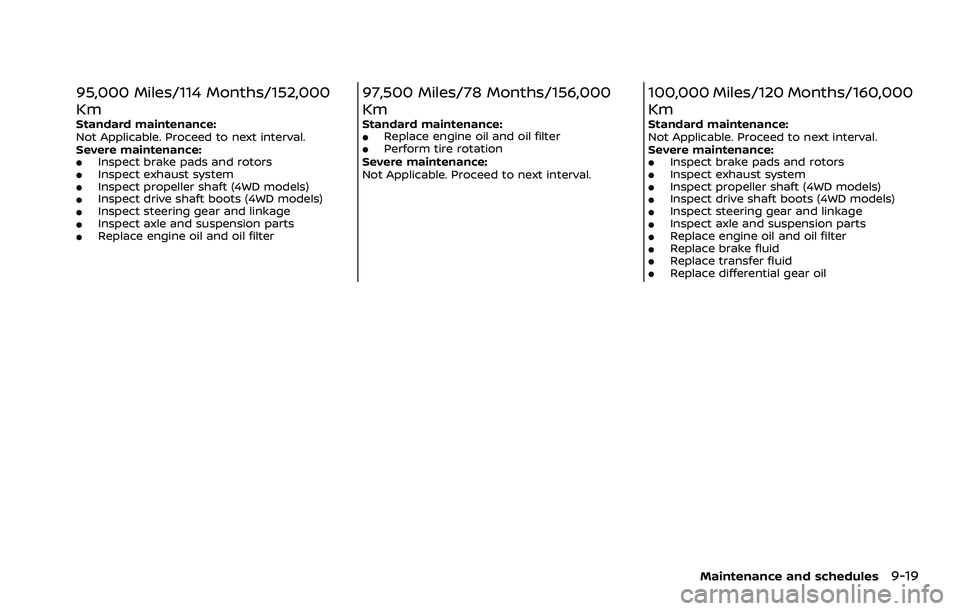
95,000 Miles/114 Months/152,000
Km
Standard maintenance:
Not Applicable. Proceed to next interval.
Severe maintenance:
.Inspect brake pads and rotors.Inspect exhaust system.Inspect propeller shaft (4WD models).Inspect drive shaft boots (4WD models).Inspect steering gear and linkage.Inspect axle and suspension parts.Replace engine oil and oil filter
97,500 Miles/78 Months/156,000
Km
Standard maintenance:.Replace engine oil and oil filter.Perform tire rotation
Severe maintenance:
Not Applicable. Proceed to next interval.
100,000 Miles/120 Months/160,000
Km
Standard maintenance:
Not Applicable. Proceed to next interval.
Severe maintenance:
.Inspect brake pads and rotors.Inspect exhaust system.Inspect propeller shaft (4WD models).Inspect drive shaft boots (4WD models).Inspect steering gear and linkage.Inspect axle and suspension parts.Replace engine oil and oil filter.Replace brake fluid.Replace transfer fluid.Replace differential gear oil
Maintenance and schedules9-19
Page 506 of 603

9-20Maintenance and schedules
105,000 Miles/84 Months/168,000
Km
Standard maintenance:.Inspect brake lines and cables.Inspect brake pads and rotors.Inspect drive belts (1).Inspect propeller shaft (4WD models).Inspect drive shaft boots (4WD models).Inspect transfer fluid.Inspect differential gear oil.Replace engine coolant (2).Replace engine oil and oil filter.Replace in-cabin microfilter.Replace spark plugs (3).Perform tire rotation.Lubricate propeller shaft grease (4WD
models)Severe maintenance:
Not Applicable. Proceed to next interval.
(1) Replace the drive belts if found damaged.
(2) First replacement interval is 105,000 miles
(168,000 km) or 84 months. After first repla-
cement, replace every 75,000 miles (120,000
km) or 60 months.
(3) Replace spark plug when the plug gap
exceeds 0.053 in (1.35 mm) even if within
specified replacement mileage.
105,000 Miles/126 Months/168,000
Km
Standard maintenance:
Not Applicable. Proceed to next interval.
Severe maintenance:
.Inspect brake pads and rotors.Inspect exhaust system.Inspect propeller shaft (4WD models).Inspect drive shaft boots (4WD models).Inspect steering gear and linkage.Inspect axle and suspension parts.Replace engine oil and oil filter
Page 507 of 603
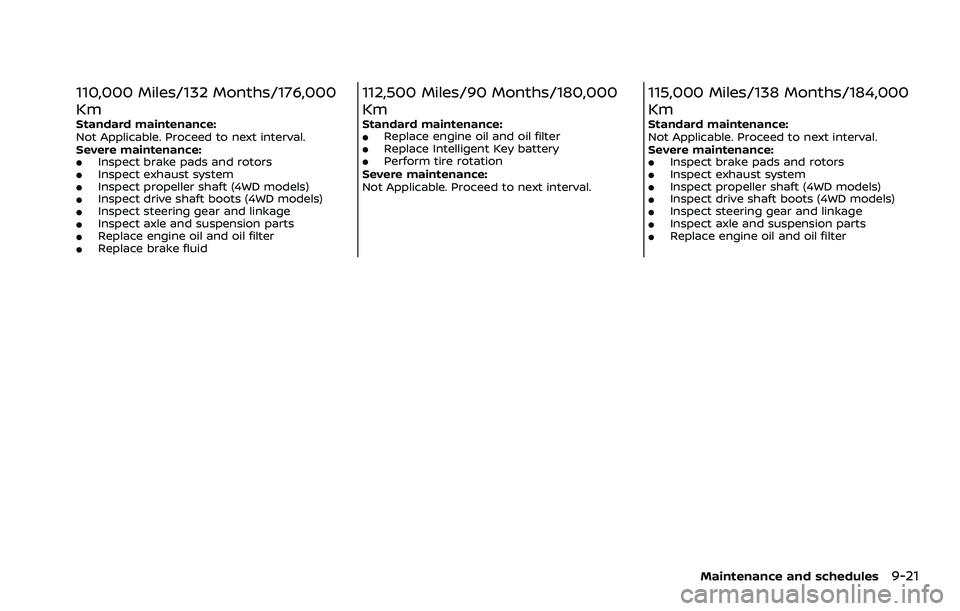
110,000 Miles/132 Months/176,000
Km
Standard maintenance:
Not Applicable. Proceed to next interval.
Severe maintenance:
.Inspect brake pads and rotors.Inspect exhaust system.Inspect propeller shaft (4WD models).Inspect drive shaft boots (4WD models).Inspect steering gear and linkage.Inspect axle and suspension parts.Replace engine oil and oil filter.Replace brake fluid
112,500 Miles/90 Months/180,000
Km
Standard maintenance:.Replace engine oil and oil filter.Replace Intelligent Key battery.Perform tire rotation
Severe maintenance:
Not Applicable. Proceed to next interval.
115,000 Miles/138 Months/184,000
Km
Standard maintenance:
Not Applicable. Proceed to next interval.
Severe maintenance:
.Inspect brake pads and rotors.Inspect exhaust system.Inspect propeller shaft (4WD models).Inspect drive shaft boots (4WD models).Inspect steering gear and linkage.Inspect axle and suspension parts.Replace engine oil and oil filter
Maintenance and schedules9-21
Page 508 of 603
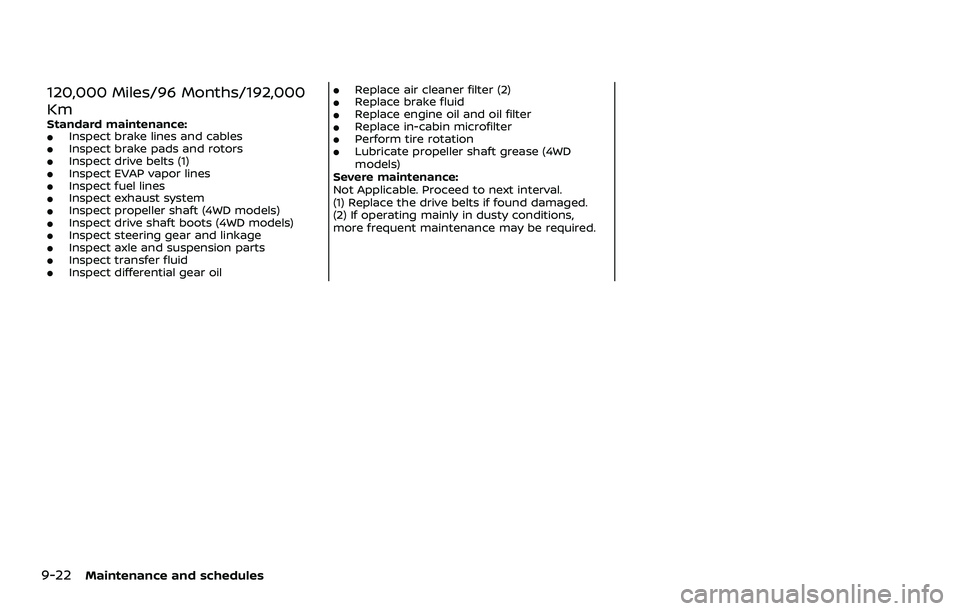
9-22Maintenance and schedules
120,000 Miles/96 Months/192,000
Km
Standard maintenance:.Inspect brake lines and cables.Inspect brake pads and rotors.Inspect drive belts (1).Inspect EVAP vapor lines.Inspect fuel lines.Inspect exhaust system.Inspect propeller shaft (4WD models).Inspect drive shaft boots (4WD models).Inspect steering gear and linkage.Inspect axle and suspension parts.Inspect transfer fluid.Inspect differential gear oil
.Replace air cleaner filter (2).Replace brake fluid.Replace engine oil and oil filter.Replace in-cabin microfilter.Perform tire rotation.Lubricate propeller shaft grease (4WD
models)
Severe maintenance:
Not Applicable. Proceed to next interval.
(1) Replace the drive belts if found damaged.
(2) If operating mainly in dusty conditions,
more frequent maintenance may be required.
Page 531 of 603
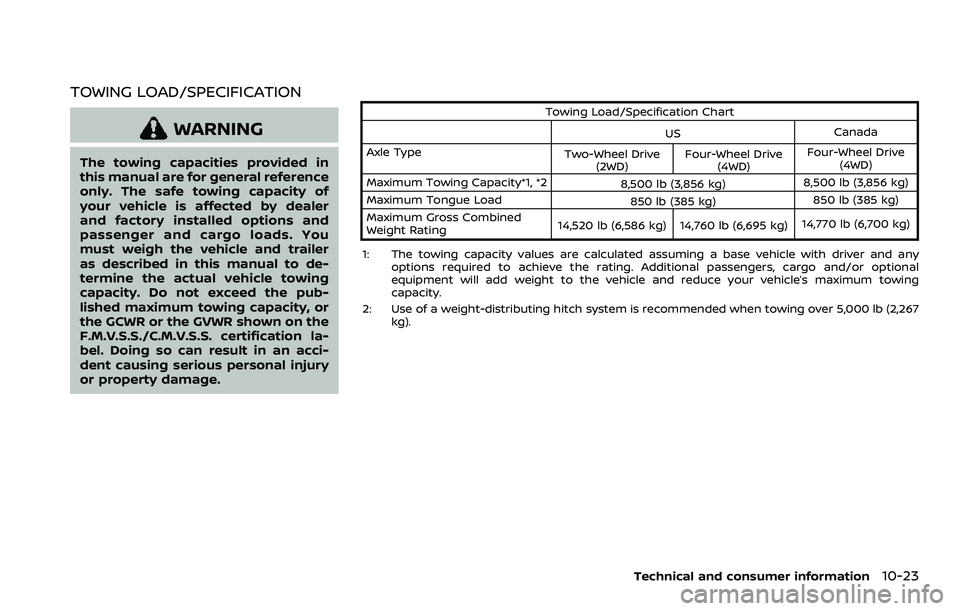
TOWING LOAD/SPECIFICATION
WARNING
The towing capacities provided in
this manual are for general reference
only. The safe towing capacity of
your vehicle is affected by dealer
and factory installed options and
passenger and cargo loads. You
must weigh the vehicle and trailer
as described in this manual to de-
termine the actual vehicle towing
capacity. Do not exceed the pub-
lished maximum towing capacity, or
the GCWR or the GVWR shown on the
F.M.V.S.S./C.M.V.S.S. certification la-
bel. Doing so can result in an acci-
dent causing serious personal injury
or property damage.
Towing Load/Specification ChartUS Canada
Axle Type Two-Wheel Drive
(2WD) Four-Wheel Drive
(4WD) Four-Wheel Drive
(4WD)
Maximum Towing Capacity*1, *2 8,500 lb (3,856 kg)8,500 lb (3,856 kg)
Maximum Tongue Load 850 lb (385 kg)850 lb (385 kg)
Maximum Gross Combined
Weight Rating 14,520 lb (6,586 kg) 14,760 lb (6,695 kg)
14,770 lb (6,700 kg)
1: The towing capacity values are calculated assuming a base vehicle with driver and any options required to achieve the rating. Additional passengers, cargo and/or optional
equipment will add weight to the vehicle and reduce your vehicle’s maximum towing
capacity.
2: Use of a weight-distributing hitch system is recommended when towing over 5,000 lb (2,267 kg).
Technical and consumer information10-23
Page 540 of 603
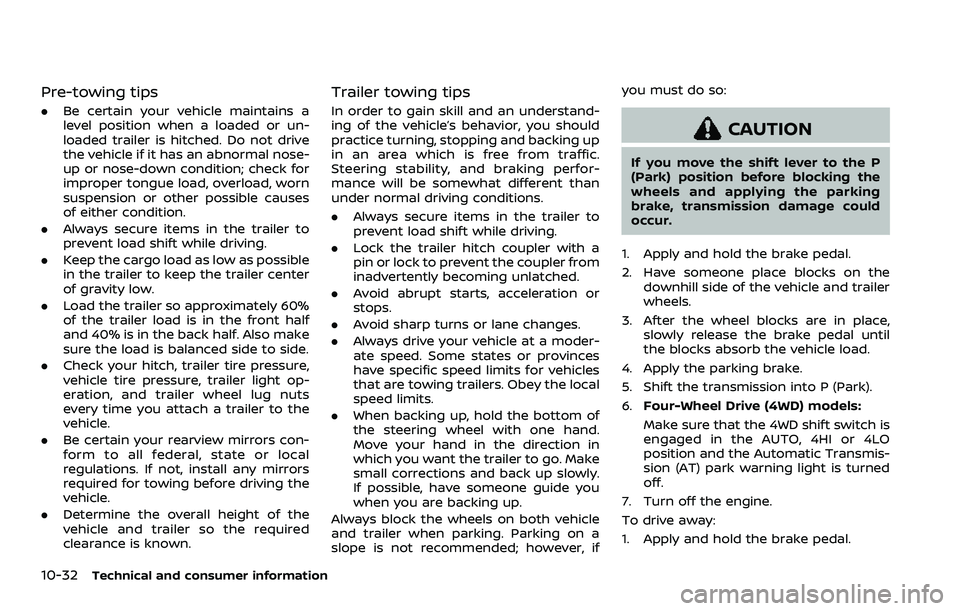
10-32Technical and consumer information
Pre-towing tips
.Be certain your vehicle maintains a
level position when a loaded or un-
loaded trailer is hitched. Do not drive
the vehicle if it has an abnormal nose-
up or nose-down condition; check for
improper tongue load, overload, worn
suspension or other possible causes
of either condition.
. Always secure items in the trailer to
prevent load shift while driving.
. Keep the cargo load as low as possible
in the trailer to keep the trailer center
of gravity low.
. Load the trailer so approximately 60%
of the trailer load is in the front half
and 40% is in the back half. Also make
sure the load is balanced side to side.
. Check your hitch, trailer tire pressure,
vehicle tire pressure, trailer light op-
eration, and trailer wheel lug nuts
every time you attach a trailer to the
vehicle.
. Be certain your rearview mirrors con-
form to all federal, state or local
regulations. If not, install any mirrors
required for towing before driving the
vehicle.
. Determine the overall height of the
vehicle and trailer so the required
clearance is known.
Trailer towing tips
In order to gain skill and an understand-
ing of the vehicle’s behavior, you should
practice turning, stopping and backing up
in an area which is free from traffic.
Steering stability, and braking perfor-
mance will be somewhat different than
under normal driving conditions.
.Always secure items in the trailer to
prevent load shift while driving.
. Lock the trailer hitch coupler with a
pin or lock to prevent the coupler from
inadvertently becoming unlatched.
. Avoid abrupt starts, acceleration or
stops.
. Avoid sharp turns or lane changes.
. Always drive your vehicle at a moder-
ate speed. Some states or provinces
have specific speed limits for vehicles
that are towing trailers. Obey the local
speed limits.
. When backing up, hold the bottom of
the steering wheel with one hand.
Move your hand in the direction in
which you want the trailer to go. Make
small corrections and back up slowly.
If possible, have someone guide you
when you are backing up.
Always block the wheels on both vehicle
and trailer when parking. Parking on a
slope is not recommended; however, if you must do so:
CAUTION
If you move the shift lever to the P
(Park) position before blocking the
wheels and applying the parking
brake, transmission damage could
occur.
1. Apply and hold the brake pedal.
2. Have someone place blocks on the downhill side of the vehicle and trailer
wheels.
3. After the wheel blocks are in place, slowly release the brake pedal until
the blocks absorb the vehicle load.
4. Apply the parking brake.
5. Shift the transmission into P (Park).
6. Four-Wheel Drive (4WD) models:
Make sure that the 4WD shift switch is
engaged in the AUTO, 4HI or 4LO
position and the Automatic Transmis-
sion (AT) park warning light is turned
off.
7. Turn off the engine.
To drive away:
1. Apply and hold the brake pedal.
Page 543 of 603
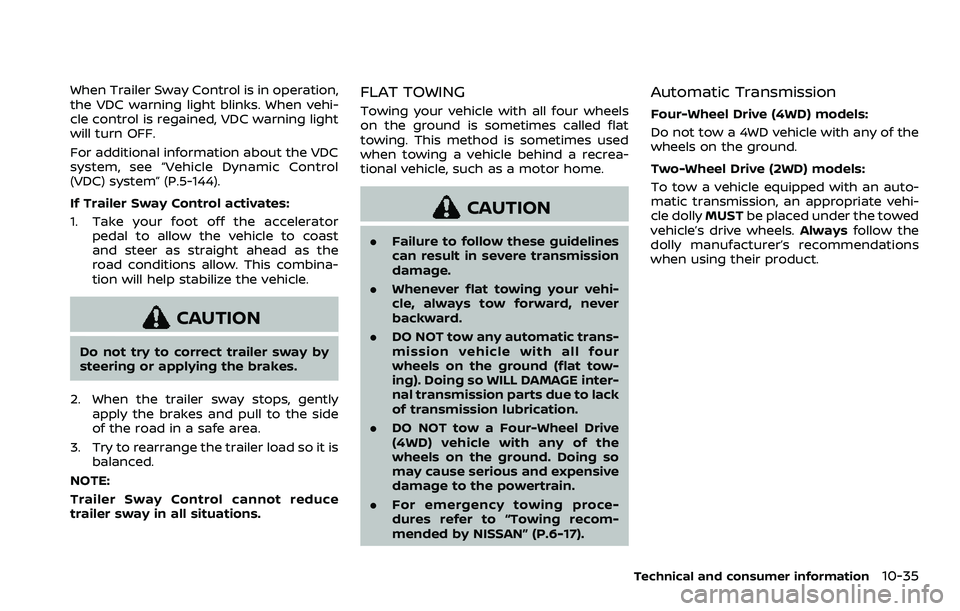
When Trailer Sway Control is in operation,
the VDC warning light blinks. When vehi-
cle control is regained, VDC warning light
will turn OFF.
For additional information about the VDC
system, see “Vehicle Dynamic Control
(VDC) system” (P.5-144).
If Trailer Sway Control activates:
1. Take your foot off the acceleratorpedal to allow the vehicle to coast
and steer as straight ahead as the
road conditions allow. This combina-
tion will help stabilize the vehicle.
CAUTION
Do not try to correct trailer sway by
steering or applying the brakes.
2. When the trailer sway stops, gently apply the brakes and pull to the side
of the road in a safe area.
3. Try to rearrange the trailer load so it is balanced.
NOTE:
Trailer Sway Control cannot reduce
trailer sway in all situations.
FLAT TOWING
Towing your vehicle with all four wheels
on the ground is sometimes called flat
towing. This method is sometimes used
when towing a vehicle behind a recrea-
tional vehicle, such as a motor home.
CAUTION
. Failure to follow these guidelines
can result in severe transmission
damage.
. Whenever flat towing your vehi-
cle, always tow forward, never
backward.
. DO NOT tow any automatic trans-
mission vehicle with all four
wheels on the ground (flat tow-
ing). Doing so WILL DAMAGE inter-
nal transmission parts due to lack
of transmission lubrication.
. DO NOT tow a Four-Wheel Drive
(4WD) vehicle with any of the
wheels on the ground. Doing so
may cause serious and expensive
damage to the powertrain.
. For emergency towing proce-
dures refer to “Towing recom-
mended by NISSAN” (P.6-17).
Automatic Transmission
Four-Wheel Drive (4WD) models:
Do not tow a 4WD vehicle with any of the
wheels on the ground.
Two-Wheel Drive (2WD) models:
To tow a vehicle equipped with an auto-
matic transmission, an appropriate vehi-
cle dolly MUSTbe placed under the towed
vehicle’s drive wheels. Alwaysfollow the
dolly manufacturer’s recommendations
when using their product.
Technical and consumer information10-35